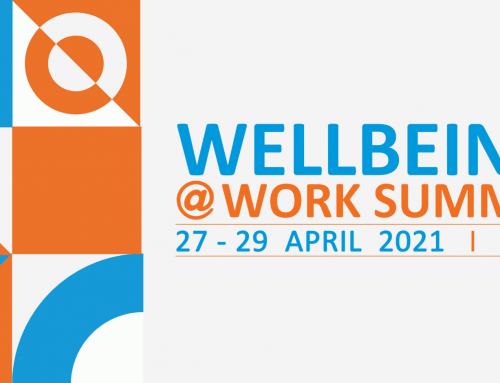‘When leaders take the opportunity to improve employee wellbeing, they create more engaging places to work and greater returns for the organisation.’
– Arianna Huffington, CEO and Editor-in-Chief, Huffington Post
I have always had a passion for health and well-being, and have been on my own personal wellbeing journey for the last 20 years – a quest that has had a massive impact on my whole life. This year, though, I have been able to work more closely with my occupational health colleagues to create a wellbeing programme or framework for our 2,000 globally based employees. We’re still very much on the first chapter, but have made some good progress and are starting to see a difference.
Let me start by highlighting the drivers for change, one of which was my own personal passion in health and wellbeing. The others were business-focused in the sense that my company, RBI, is ambitious and keen to grown and improve performance through innovation and other initiatives which are dependent on people. That, coupled with some pretty alarming trends and data sets in workplace, caused stress, and its impact on both employee wellbeing and company performance have certainly helped get the economics of wellbeing on our company’s agenda. After all, you can’t have a healthy business with sick employees.
And sickness through stress in particular is a big issue, with as much as 78% of the general working population claiming that stress is affecting their mood, sleep and health (according to one study by the Stress Management Society)!
Perhaps, it’s not really surprising. The last decade has been full of change. For instance, my company has completely transformed from being a very traditional, UK-based magazine publisher to an online subscription business servicing companies around the world. A big success story, and as the marketing director for the business over this period, it has certainly been a fascinating and challenging experience. However, from an employee point of view, change and uncertainly tend to not be good for employee wellbeing!
This year, with the company back in the black and keen to invest and grow, we’ve developed a more holistic approach to wellbeing, to help our people flourish. It’s very much the beginning of our wellbeing story, but I want to share with you the story so far. I’m not saying it has been easy, few things worth having are, but for me, it has been extremely rewarding, enabling me to bring my own knowledge and passion for holistic wellbeing that has served me so well on a personal level to a much wider group. And you can do it, too.
Looking back at the process, there are really three key steps to take, not necessarily in sequence:
Step 1: Discovery.
- The very first step was meeting up with our Occupational Health Advisor, Maria Goldby, to find out what we, as an organisation, already did from a health and wellbeing perspective, and whether there was any appetite to do more. It was a very positive meeting, and I discovered that we did a lot more than I realised, and that there were opportunities to join-up the initiatives and increase awareness and engagement by creating a more integrated programme.
- Who else is interested in wellbeing? Our next step was pulling together a few other people who were interested in health and wellbeing to brainstorm ideas. Our own research indicated that about 15% of our employee community were engaged in health, which is quite typical. In other words, they are proactive in incorporating healthy practices into their life irrespective of what their employer does. Over time, this small group expanded into a ‘wellbeing champion group’ spread around the different offices around the world.
- What would employees like to see happen? Getting ideas of what we could do wasn’t hard. We had lists of things, but to help prioritise, we did a simple survey over the summer which got a fantastic response. Over half the company responded and gave us some great insights and real confidence to move forward. The data also helped us segment employees into groups like ‘the health engaged’ and ‘the worried well,’ as well as ‘the refusers’ which represented quite a chunk, so we could focus on the groups we wanted to connect with.
- What are other companies doing that you can learn from? I also learnt a lot by interviewing wellbeing champions in other companies who are already proactive with their wellbeing agenda, and this provided some useful metrics and learning to support the investment case. Although approximately only 19% of UK companies are proactive with their wellbeing agenda, this is definitely a growing trend across many sectors, particularly the service sectors, financial services and retail. I also learn’t a lot from US-based companies which are further ahead with their wellbeing agendas.
- Who can help you? Reaching out to the supply chain also proved to be a valuable resource, and there are some great entrepreneurial organisations out there that have created services and platforms to help you implement a wellbeing programme efficiently.
Step 2: Engagement.
The difference between success and failure of any initiative is how aware and engaged employees are. Thus, internal marketing has been a big focus for us, which included:
- Creating a wellbeing steering group made up of the people who can make things happen, ie. HR, Facilities, Canteen, Corporate Communications. I started by getting a group together to discuss what was possible and how things could work.
- Getting the leadership team on board at the appropriate time. Once some momentum had built up and there was a story to tell, I pitched the whole initiative to the senior leadership team to get their support and participation, using increasingly available data linking the existence of wellbeing initiatives to business performance. Senior involvement is, as you’d expect, a critical component to the success of any wellbeing programme.
- Developing a Wellbeing Champion Network. I mentioned this before. This network has evolved organically and has expanded as awareness grows. I coordinate the group and use social media to connect them and share resources and ideas around the world. One thing that has pleasantly surprised me is the amount of hidden skill and knowledge we have within the business, with yoga teachers, nutritionists and other practitioners already on the staff!
- Video – we shot a video to get the positioning of the wellbeing programme right and tell the RBI Wellbeing story. We wanted to make sure that we connected with the groups of people we were targeting, so created a story to share which you can view here.
- Wellbeing Fair – finally, a lot of our thinking has come together in the form of a wellbeing fair. It’s a broad wellbeing event, with a focus on ‘Knowing Your Numbers’ in response to the feedback from the survey. The event took place last week and went better than I could have hoped, delivering a high energy experience with something for everyone.
Step 3: Resources, metrics and strategy
The final piece has been around resources, success metrics and strategy. From a resource perspective, with the exception of the two Occupational Health Advisors whose time is mainly taken up dealing with cases, there have been no dedicated resources. We expanded our Occupational Health team’s remit to cover wellbeing and have tried to be as resourceful as possible, relying on a network of volunteers to give up time. We did hire a fantastic company, Kamwell, who specialise in employee wellbeing, to help us organise the wellbeing fair which wouldn’t have happened without them.
Where we’re going?
So, it’s still early days, but we’re on a journey and ripples are starting to form that are making a positive difference to the working environment. From here, we’re looking to build upon the success from this year to create initiatives around the seasons for 2015, creating a stronger infrastructure getting sharper on metrics so that we can understand the impact of our initiatives to secure future investment.
Finally, whilst I started the journey with a real passion for physical wellbeing, our model of wellbeing is really much broader than that, incorporating both physical and emotional wellbeing as well as environmental wellbeing as we are much more than our physical bodies operating in isolation.
‘People are what make RBI great, and we value our people. Their health and wellbeing are essential to the performance of our business.’
– Dominic Feltham, CEO, RBI











